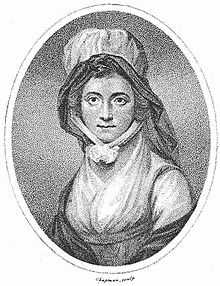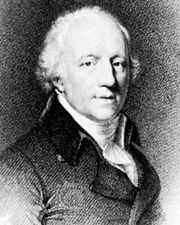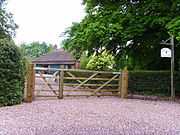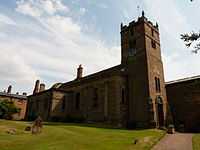Honora Sneyd
| Honora Sneyd | |
|---|---|
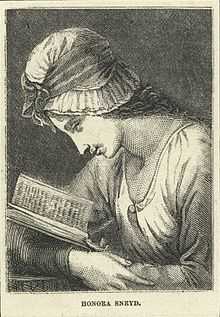 | |
| Born |
1751 Bath, Somerset |
| Died |
(aged 28) Weston-under-Lizard, Staffordshire |
Resting place | Weston-under-Lizard, Staffordshire |
| Nationality | British |
| Occupation | Writer, educator |
| Spouse(s) | Richard Lovell Edgeworth |
| Children |
|
| Parent(s) |
|
| Relatives |
|
Honora Sneyd (Honora Edgeworth, née Sneyd )[notes 1] (1751 – 1 May 1780) was an eighteenth century English writer, mainly known for her associations with literary figures of the day, particularly Anna Seward, the Lunar Society and for her work on children's education.
She was born in Bath in 1751, and following the death of her mother in 1756 was raised by Canon Thomas Seward and his wife in Lichfield, Staffordshire where she formed a close friendship with Anna Seward, until she returned to her father's house in 1771. Having had a romantic engagement to John André and having declined the hand of Thomas Day, she married Richard Edgeworth as his second wife in 1773, living on the family estate in Ireland till 1776. There she helped raise his daughter Maria Edgeworth, and two children of her own. Returning to England she fell ill with tuberculosis, which was incurable, dying at Weston in Staffordshire in 1780. She is the subject of a number of Anna Seward's poems, and with her husband developed concepts of childhood education. She was a staunch supporter of women's rights.
Life
Early life 1751–1756
Honora Sneyd was born the third daughter to Edward Sneyd, of Bishton (1711–1795), Staffordshire[3] and Susanna Cook in Bath, in 1751. Her father was a Major in the Royal Horse Guards,[4] with an appointment at Court as a Gentleman Usher.[5] Honora was one of eight children and the second surviving daughter, and when her mother died in 1756 when Honora was six,[6][7] various friends and relations offered to take care of his daughters, their father being unable to do so.[8][5]
Adoption by the Seward family 1756–1771
Honora Sneyd, who was seven years younger than the thirteen-year-old Anna Seward (1742–1809),[8] moved into the home of Canon Thomas Seward and his family at Lichfield, Staffordshire, where they lived in the Bishop's Palace in the Cathedral Close. There she was brought up by the Sewards as one of their own, being variously described as an adopted or foster sister.[5][9][10] Anna Seward describes how she and her sister first met Honora, on returning from a walk, in her poem The Anniversary (1769). Initially she was more attached to Sarah (1744–1764),[11] the younger Seward daughter to whom she was closer in age, but Sarah died of typhus at the age of nineteen (1764), when Honora Sneyd was thirteen. Following Sarah's death she became the responsibility of Anna, the older sister.[12] Anna consoled herself with her affection for Honora Sneyd, as she describes in Visions, written a few days after her sister's death. In the poem she expresses the hope that Honora ('this transplanted flower') will replace her sister (whom she refers to as 'Alinda') in her and her parents affections.[13] Throughout her life, her health was fragile, experiencing her first bout of the tuberculosis that would later claim her life at the age of fifteen.[14]
Education
At Lichfield she came under the influence of Canon Seward and his progressive views on female education, having authored The Female Right to Literature (1748).[15] She was described as clever and interested in science,[16] From Anna she developed a great love of literature.[12]
Honora Sneyd was an accomplished scholar, attending day school in Lichfield she became fluent in French, translating Rousseau's Julie for her older foster sister.[8] Though Canon Seward's (but not his wife's) attitudes towards the education of girls was progressive relative to the times, they were not excessively liberal. Amongst the subjects he taught them was theology and numeracy, and how to read and appreciate poetry, and also how to write and recite poetry. Although this deviated from what were considered ' conventional drawing room accomplishments', the omissions were also notable, including languages and science, although they were left free to pursue their own inclinations.[8] They were however exposed to the circle of learned men who frequented the Bishop's Palace at Lichfield where they lived, which became the centre of a literary circle including Erasmus Darwin, Samuel Johnson and James Boswell. The children were encouraged to participate as Anna later relates.[notes 2][17][9]
Relationships
Honora Sneyd and Anna Seward lived under the same roof for thirteen years and formed a close friendship which has given rise to much speculation as to its exact nature.[18] She had a reputation for both intelligence and beauty, as commented on by both Anna Seward and Richard Edgeworth (1744–1817). .[19][20][8] At seventeen[13] Honora Sneyd was briefly engaged to a Swiss born Derbyshire merchant, John André (1750–1780), a relationship that Seward had fostered, and wrote about in her Monody on Major André (1781)[21][22] when André became a British officer in 1771 and was hanged as a spy by the Americans.[notes 3] The respective parents did not support this attachment for reasons of his financial status.[23]
Around Christmas 1770 Thomas Day (1748–1789) and Richard Edgeworth were spending increasing amounts of time at the Seward household and both had fallen for Honora, although Edgeworth was already married.[20] In 1771 she declined an offer of marriage from Thomas Day.[24] Edgeworth gives an account of her letter of rejection stating that it "contained an excellent answer to his arguments in favour of the rights of men, and a clear dispassionate view of the rights of women". Edgeworth continues that Honora Sneyd had very determined views on the role of women and their rights within marriage.[25]
However Honora's father moved to Lichfield from London in 1771, and reassembled his family of five daughters there. By now Honora was nineteen and Anna viewed her friend's departure with considerable dismay.[26] Although Day was much distressed by his rejection by Honora, he transferred his affections to the fifth daughter, Elizabeth, who had been in the care of the Powys' in Shrewsbury, Mrs. Powys being Mr Sneyd's niece.[27][16][28] However she was not inclined to accept him.[29]
Richard Lovell comments on how she had affected him;
During this intercourse I perceived the superiority of Miss Honora Sneyd's capacity ... her sentiments were on all subjects so just and were delivered with such blushing modesty though not without an air of conscious worth as to command attention from every one capable of appreciating female excellence. Her person was graceful her features beautiful and their expression such as to heighten the eloquence of every thing she said. I was six and twenty and now for the first time in my life I saw a woman that equalled the picture of perfection which existed in my imagination.[20]
He continued, describing the unhappiness of his marriage, and how that made him vulnerable to her attributes, which were share by all the learned gentlemen of his circle. He also believed that Anna Seward had noticed the effect her friend was having on him, and would regularly place her actions in the best light for his benefit.[22]
Honora Edgeworth 1773–1780
In March 1773 Edgeworth's first wife, Anna Maria Elers (1743–1773) died ten days after giving birth to their fourth child, Anna Maria Edgeworth (1773–1824), at the age of 29, thought to be from puerperal fever.[30][31][notes 4] Edgeworth had retreated to Lyon in France in the autumn of 1771 to avoid temptation once his friend Day had been rejected,[32] leaving his expectant wife in the care of Day. He promptly headed to Lichfield to see Honora at the Sneyds, with the intention of proposing.[33] Edgeworth, a member of the Lunar Society, had corresponded regularly with Seward, and although Seward was opposed to the marriage, the couple were married at Lichfield Cathedral on 17 July 1773, officiated by Canon Thomas Seward, Anna Seward being a bridesmaid.[34][35] Within eight years of her marriage she would be dead at almost the same age as her predecessor. After marrying the couple immediately moved to the family estate at Edgeworthstown, County Longford in Ireland.[7][35]
Through this marriage Sneyd became step-mother to Maria Edgeworth (1768 – 1849), another writer, Richard Edgeworth's second child by his first wife, who was five years old at that time. She had two children while in Ireland, Honora Edgeworth (1774–1790) who died at 16, and Lovell Edgeworth (1775–1842), who inherited the property. In addition she had Anna Maria's four children (Richard b. 1764, Maria b. 1768, Emmeline b. 1770, Anna Maria b. 1773) ranging from nine to seven months in age [36] to take care of,[37] although eventually the eldest, Richard Edgeworth (1765–1796) was sent away to boarding school,[38] as was Maria Edgeworth (1768-1849) from 1775 to 1782.[39] The children were raised according to the system of Rousseau, as refined and modified by the Edgeworths.[40] Richard Edgeworth considered his early educational efforts a failure, both of the older children growing up unruly and then being sent away to school. However he had seen very little of them in their early years.[39]
After three years in Ireland, in 1776 they moved to England again, taking up residence in Northchurch, Hertfordshire.[41] Despite Anna Seward's despair at the loss of her friend, she and Honora maintained regular correspondence and visits, which suddenly ceased, an event that Anna blamed Honora's father for.[42] During a temporary absence of Mr. Edgeworth on business in Ireland, Honora Edgeworth fell ill, just as he was summoning her to join him.[43] On his return they consulted Dr. Erasmus Darwin at Lichfield, who was of the opinion the illness was more severe than at first thought, being a recurrence of consumption (T.B.) from which she had had a brief bout at the age of fifteen.[44] He advised against returning to Ireland but rather, moving closer to Lichfield. For a while they stayed at the Sneyd house that was temporarily vacant while consulting a wide range of physicians, but only received news of incurability. Eventually they rented Bighterton,[notes 5] near Shifnal, Shropshire.[45] Four years after returning to England Honora Sneyd died of consumption on May 1, 1780[notes 6] at Bighterton, surrounded by her husband, her sister Charlotte and a servant.[46] She was buried in the nearby Weston church where a plaque on the wall (see box) bears witness to her life.[47][notes 7]
On Honora Sneyd's death, Edgeworth married her sister, Elizabeth Sneyd, which had been the dying wish of Honora.[46] Although legal this was considered scandalous, and was opposed by both the Sneyds and the Sewards as well as the Bishop. The couple fled to London where they were married on Christmas Day.[48][49]
Sneyd was also the subject of many of Seward's poems,[18] and has been considered to have been in a lesbian relationship with her. When Sneyd married, she became the subject of Seward's anger, yet she continued to write about her and her affection for her long after her death.[50]
Work
Richard Edgeworth's attempts to raise his eldest son Richard according to the principles of Rousseau, was deemed a failure after eight years.[51] After the birth of Honora's first child (1774),[notes 8] the Edgeworths embarked on a plan, partly inspired by Anna Barbauld, to write a series of books for children.[52][53] The impetus came from the pair designing a plan for the education of their children. They started by reviewing the existing literature on childhood education (including Locke, Hartley, Priestley and Rousseau), and then proceeded to document their observations of the behaviour of children and then developing their own 'practical' system. Erasmus Darwin had suggested they start by reading the work of Dugald Stewart. Honora then started recording extensive notes on her observations of the Edgeworth children. These then became the dialogues in the final book.[53]
After her premature death, her sister Elizabeth continued the work, in her role as the third wife of Richard Edgeworth.[54] The Edgeworths state that "She was of opinion that the art of education should be considered as an experimental science", and that the failures of the past were due to "following theory rather than practice". She conceived of the title of their work therefore as Practical Education.[55][51] With her husband, she wrote the first version of Practical Education as a children's book Practical education: or, the history of Harry and Lucy for Honora her daughter, which was begun in 1778 and privately published in 1780 in Lichfield.[56] The final version was authored by her husband and Maria Edgeworth and published after both her and her sister's deaths, in 1798, although in reality it was a family project that would extend over 50 years (c. 1774–1825).[53][notes 9][7][57][58][48] She also put together a register (published in 2 volumes 1778–1779)[59] of the reaction of children to new knowledge, given her interest in applying experimental science to the field of child education.[7][53] This formed the basis of her husband's Essays on professional education (1809). In the Bodleian Library there is a short story in manuscript dated 1787 and other fragments attributed to her.[7][59][notes 10]
Honora Sneyd worked with her inventor husband and became an excellent theoretical mechanic herself.[60][61]
Legacy
Since little of Honora Sneyd's own words have survived, our image of her is largely through the eyes of others, in particular Anna Seward and Richard Edgeworth. Anna Seward's will mentions two likenesses in her possession that she wished to bequeath — a mezzotinto engraving after Romney to Honora's brother Edward, and a drawn miniature portrait by John André (1776) to her cousin Mary Powys.[62]
In addition to being immortalised in Anna Seward's poetry, she appears semi-fictionalised as a character in a play about her and Major André, André; a Tragedy in Five Acts by William Dunlap, first produced in New York in 1798. The plaque in St. Andrew's Church, Weston, where she is buried, on the north wall of the tower, reads;[47] <div class="quotebox "toccolours" style="max-width:40%; width:20em; margin-right: 0em; margin-right: 1em;"" style="
margin: auto; width:25%; padding: 6px; border: 1px solid #aaa; font-size: 88%; background-color: #F9F9F9; ">
MDCCLXXX
Near this place was buried
HONORA EDGEWORTH,
aged 28 years.
Her Manners, Wisdom, and Virtue,
gained Admiration and Esteem,
without exciting
Envy.
Notes
- ↑ Some sources spell her name 'Honoria' (Fraser's 1832), however she styled herself Honora Sneyd Edgeworth in her publications
- ↑ "and being canon of this cathedral, his daughter necessarily converses on terms of equality with the proudest inhabitants of our little city" (Scott 1810, Letter February 1763. vol. I p. lxxiii)
- ↑ The Edgeworths pointed out an error in the poem that suggested that André enlisted in reaction to news of Honora's marriage. In fact he enlisted two years earlier in 1771. (Edgeworth & Edgeworth 1801, Appendix p. 301)
- ↑ Some sources say she died in childbirth, (Colvin 2015) (Edgeworth & Edgeworth 1821a, p. 318) which would place Anna Maria Edgeworth's birthdate as March 1773 not 1772 as other sources state (Lundy 2015, Richard Lovell Edgeworth)
- ↑ A 19th century history of Staffordshire locates this as a farm house in Weston-under-Lizard, just across the county border in Staffordshire, also spelt Beighterton (Collections for a history of Staffordshire 1899, p. 278)
- ↑ Many sources give the date of death as April 30, but the Edgeworths state she died the following morning
- ↑ The Edgeworths give the place of burial as King's Weston, near Bristol. This appears to be an error, given the evidence from the parish of Weston (Shropshire) itself. Furthermore Anna Seward gives an account of a visit to the grave in the following year in Lichfield, an Elegy (May 1781), to which Scott adds a note that this is the 'Weston, on the edge of Shropshire'. (Scott 1810, Lichfield, an Elegy May 1781, vol. I p. 89) Richard Edgeworth had not completed his memoirs at the time of his death in 1817, thirty seven years later, and they were completed by Maria Edgeworth in 1821. Maria was only 12 when her step mother died.
- ↑ Once source attributes to Maria the statement that the date of the start of this project was 1778, but this seems rather late. The oldest step child (Richard) would have been fourteen by then and her own daughter Honora four, but also this was only two years before her death (Hall 1849)
- ↑ Honora Edgeworth's contributions are discussed in the Preface to Volume I (Edgeworth & Edgeworth 1811, Preface p. x) and the Appendix to Volume II (Edgeworth & Edgeworth 1801, Appendix p. 301)
- ↑ The authorship of these publications is complex, as outlined by Myers. (Myers 1999) Honora Sneyd wrote two short stories entitled Practical Education that were published after her premature death, in 1780. Maria Edgeworth then revised and republished these Harry and Lucy stories as part of Early Lessons (1801) (Edgeworth 1801)
References
- ↑ Hopwood 1811.
- ↑ Chamberlain 1910, Appendix II. Honora Sneyd and the 'Serena' pictures pp.386–389.
- ↑ Lundy 2015, Edward Sneyd.
- ↑ Gentleman's Magazine 1795, Obituaries p. 84.
- ↑ 5.0 5.1 5.2 Butler 1972, p. 41.
- ↑ Bowerbank 2015.
- ↑ 7.0 7.1 7.2 7.3 7.4 Loeber et al. 2015.
- ↑ 8.0 8.1 8.2 8.3 8.4 Barnard 2013, p. 36.
- ↑ 9.0 9.1 Edgeworth & Edgeworth 1821a, p. 232.
- ↑ Barnard 2013, p. 5.
- ↑ Barnard 2013, p. 29.
- ↑ 12.0 12.1 Edgeworth & Edgeworth 1821a, p. 234.
- ↑ 13.0 13.1 Scott 1810, The Visions, vol. I p. 1.
- ↑ Barnard 2013, p. 37.
- ↑ Dodsley 1765, Seward, T. The Female Right to Literature Volume 2, pp. 309–315.
- ↑ 16.0 16.1 Uglow 2002a, pp. 322–324.
- ↑ Barnard 2004.
- ↑ 18.0 18.1 deLucia 2013.
- ↑ Seward 1804, p. 30.
- ↑ 20.0 20.1 20.2 Edgeworth & Edgeworth 1821a, p. 235.
- ↑ Scott 1810, Monody on Major André, vol. II p. 68.
- ↑ 22.0 22.1 Edgeworth & Edgeworth 1821a, p. 236.
- ↑ Edgeworth & Edgeworth 1821a, p. 237.
- ↑ Fraser's 1832, p. 556.
- ↑ Edgeworth & Edgeworth 1821a, p. 243.
- ↑ North 2007.
- ↑ Edgeworth & Edgeworth 1821a, p. 244–245.
- ↑ Edgeworth & Edgeworth 1821a, p. 246.
- ↑ Edgeworth & Edgeworth 1821a, p. 330.
- ↑ Butler 1972, p. 45.
- ↑ Lundy 2015, Anna Maria Elers.
- ↑ Butler 1972, p. 42.
- ↑ Edgeworth & Edgeworth 1821a, p. 316.
- ↑ Uglow 2002a, p. 329.
- ↑ 35.0 35.1 Edgeworth & Edgeworth 1821a, p. 321.
- ↑ MacDonald 1977.
- ↑ Uglow 2002a, pp. 386.
- ↑ Edgeworth & Edgeworth 1821a, p. 348.
- ↑ 39.0 39.1 Manley 2012.
- ↑ Edgeworth & Edgeworth 1821a, p. 172.
- ↑ Edgeworth & Edgeworth 1821a, p. 329.
- ↑ Barnard 2013, p. 71.
- ↑ Edgeworth & Edgeworth 1821a, p. 356.
- ↑ Edgeworth & Edgeworth 1821a, p. 358.
- ↑ Edgeworth & Edgeworth 1821a, p. 361.
- ↑ 46.0 46.1 Edgeworth & Edgeworth 1821a, p. 364.
- ↑ 47.0 47.1 Collections for a history of Staffordshire 1899, p. 325.
- ↑ 48.0 48.1 Colvin 2015.
- ↑ Uglow 2002a, pp. 546.
- ↑ Faderman 1981, pp. 132–136.
- ↑ 51.0 51.1 O'Connor 2010, p. 30.
- ↑ Uglow 2002a, p. 543.
- ↑ 53.0 53.1 53.2 53.3 Myers 1999.
- ↑ Nash 2006, Narain, M. Not the Angel in the House p.59.
- ↑ Edgeworth & Edgeworth 1801, Appendix pp. 301–302.
- ↑ Edgeworth & Edgeworth 1780.
- ↑ Fraser's 1832, pp. 557–8.
- ↑ Edgeworth 1820, p. 1216.
- ↑ 59.0 59.1 Bodleian 1993.
- ↑ Uglow 2002a, p. 386.
- ↑ Edgeworth & Edgeworth 1821a, p. 347.
- ↑ Lady's Monthly 1812, Miss Seward's Will Wednesday 1 April 1812 pp. 190–195.
Bibliography
- Chamberlain, Arthur Bensley (1910). George Romney. London: Methuen. Retrieved 19 March 2015.
- Curtis, Stanley James; Boultwood, Myrtle E. A. (1977). A short history of educational ideas (5th ed.). University Tutorial Press. ISBN 9780723107675.
- Faderman, Lillian (1981). Surpassing the love of men: romantic friendship and love between women from the Renaissance to the present. London: Women's Press. ISBN 9780704339774.
- Gottlieb, Evan; Shields, Juliet, eds. (2013). Representing place in British literature and culture, 1660–1830 : from local to global. Farnham. ISBN 9781409419303.
- DeLucia, JoEllen. Mundy’s Needwood Forest and Anna Seward’s Lichfield Poems. pp. 155–172. in Gottlieb & Shields (2013)
- Loeber, Rolf; Loeber, Magda; Burnham, Anne Mullin. "Honora Edgeworth". A Guide to Irish Fiction 1650 - 1900. National University of Ireland. Retrieved 17 March 2015.
- Lundy, Darryl (2015). "Home". The Peerage: A genealogical survey of the peerage of Britain as well as the royal families of Europe.
- O'Connor, Maura (2010). The Development of Infant Education in Ireland, 1838-1948: Epochs and Eras. Bern: Lang. ISBN 9783034301428. Retrieved 31 March 2015.
- Uglow, Jenny (2002a). The lunar men: five friends whose curiosity changed the world. New York: Farrar, Straus & Giroux. ISBN 9780374194406.
- —— (5 October 2002b). "Educating Sabrina". The Guardian. Retrieved 18 March 2015.
- "Serena Reading (called Honora Edgeworth (née Sneyd))" (STIPPLE ENGRAVING BY JAMES HOPWOOD, AFTER GEORGE ROMNEY). National Portrait Gallery. 1811. Retrieved 19 March 2015.
- "George Romney" (SERENA READING, BY GEORGE ROMNEY. MODEL: HONORA SNEYD). The Romney Society. Retrieved 19 March 2015.
- "The Four Wives of Richard Lovell Edgewort & The Children of Richard Lovell Edgeworth" (IMAGES). English-Irish Edgeworths. House of Edgeworth, South Carolina. Retrieved 24 March 2015.
- "Edgeworthstown House, Co. Longford". Ask About Ireland. Retrieved 25 March 2015.
- Hopwood, James (1811). "Miss Sneyd. Engraved by Hopwood from a painting by Romney" (IMAGE). British portraint prints. National Library of Ireland. Retrieved 30 March 2015.
Anna Seward
- Barnard, Teresa (2004). "Anna Seward and the Battle for Authorship". Corvey Women Writers on the Web 1796–1834 (1 Summer). Retrieved 28 February 2015.
- —— (2013). Anna Seward: A Constructed Life: A Critical Biography. Farnham: Ashgate. ISBN 9781409475330. Retrieved 24 February 2015.
- Barrett, Redfern Jon (2012). ""My Stand": Queer Identities in the Poetry of Anna Seward and Thomas Gray". Gender Forum (39). Retrieved 17 March 2015.
- North, Alix (2007). "Anna Seward 1747-1809". Isle of Lesbos. Retrieved 4 March 2015.
The Edgeworths
- Butler, Marilyn (1972). Maria Edgeworth: A Literary Biography. Oxford University Press. ISBN 978-0198120179. Retrieved 31 March 2015.
- Lawless, Emily (1904). Maria Edgeworth. London: Macmillan. Retrieved 24 March 2015.
- MacDonald, Edgar E. (1977). The Education of the Heart: The Correspondence of Rachel Mordecai Lazarus and Maria Edgeworth. UNC Press. ISBN 9781469606095.
- Manley, Susan (2012). "Maria Edgeworth (1768-1849)" (PDF). Biographies of Women Writers. Chawton House Library. Retrieved 30 March 2015.
- Myers, Mitzi (Winter 1999). ""Anecdotes from the Nursery" in Maria Edgeworth's Practical Education (1798): Learning from Children "Abroad and At Home"" (PDF). Princeton University Library Chronicle 60 (2): 220–250. Retrieved 30 March 2015.
- Nash, Julie, ed. (2006). New essays on Maria Edgeworth. Aldershot: Ashgate. ISBN 9780754651758.
Historical sources
- Dodsley, Robert, ed. (1765) [1748]. A collection of Poems in six volumes by Several Hands. London: Dodsley. Retrieved 23 March 2015.
- Froude, James Anthony; Tulloch, John (1832). "Miss Edgeworlh's Tales and Novels". Fraser's Magazine 6 (November): 541–558. Retrieved 18 March 2015.
- Hall, S. C. (1849). "Edgeworthstown: Memories of Maria Edgeworth". Living Age 22: 320–329. Retrieved 30 March 2015.
- Lovett, Richard (1888). Irish pictures drawn with pen and pencil. London: The Religious Tract Society. Retrieved 30 March 2015.
- Seward, Anna (1804). Memoirs of the Life of Dr. Darwin: Chiefly During His Residence in Lichfield: With Anecdotes of His Friends, and Criticisms on His Writing. Philadelphia: W.M. Poyntell. Retrieved 24 February 2015.
- Scott, Walter, ed. (1810). The Poetical Works of Anna Seward with Extracts from her Literary Correspondence (3 VOLS.). Edinburgh: James Ballantyne.
- The William Salt Archaeological Society, ed. (1899). Collections for a history of Staffordshire Volume XX New Series Volume II History of the Manor and Parish of Weston-under-Lizard, in the County of Stafford. London: Harrison and Sons. Retrieved 18 March 2015.
- Gentleman's Magazine, 65 Part I, 1795
- A Society of Ladies, ed. (1812). "Polite Repository of Amusement and Instruction". The Lady's Monthly Museum, New Series 12. Retrieved 4 March 2015.
Works by the Edgeworths
- Edgeworth, Honora Sneyd; Edgeworth, Richard Lovell (1780). Practical Education; or, The History of Harry and Lucy, vol. 2. Lichfield: J. Jackson.
- Edgeworth, Richard Lovell; Edgeworth, Maria (1821a). The Memoirs of Richard Lovell Edgeworth 1 (2nd ed.). London: Hunter, Cradock & Joy.
- ——; —— (1821b). The Memoirs of Richard Lovell Edgeworth 2 (2nd ed.). London: Hunter, Cradock & Joy. Retrieved 17 March 2015.
- Review: Lady's Monthly Museum 1820 p. 326
- Edgeworth, Maria (1801). Early Lessons (1st ed.). London: Johnson. Retrieved 31 March 2015.
- Edgeworth, Maria (1820). "RL Edgeworth Esq". The Annual Register. Part II: 1215–1223.
- ——; Edgeworth, Richard (1811) [1798]. Essays on Practical Education 1 (3rd ed.). London: Johnson.
- ——; —— (1801) [1798]. Essays on Practical Education 2 (American ed.). Washington's Head: Hopkins.
Reference materials
- Bowerbank, S. "Seward, Anna (1742–1809)". Oxford Dictionary of National Biography (online ed.). Oxford University Press. doi:10.1093/ref:odnb/25135. (Subscription or UK public library membership required.)
- Colvin, Christina Edgeworth. "Edgeworth, Richard Lovell (1744–1817)". Oxford Dictionary of National Biography (online ed.). Oxford University Press. doi:10.1093/ref:odnb/8478. (Subscription or UK public library membership required.)
- McCormack, W. J. "Edgeworth, Maria (1768–1849), novelist and educationist". Oxford Dictionary of National Biography (online ed.). Oxford University Press. doi:10.1093/ref:odnb/8476. (Subscription or UK public library membership required.)
- Encyclopaedia Brittanica vol. VII (Ninth (American) ed.). Philadelphia: Maxwell Summerville. 1891.
- Priestman, Judith; Clapinson, Mary; Rogers, Tim (1993). "Catalogue of the papers of Maria Edgeworth (1768-1849), and the Edgeworth family, 17th–19th century". University of Oxford, Bodleian Library. Retrieved 18 March 2015.
- "Edgeworth Papers. Collection List 40" (PDF). National Library of Ireland. p. 112. Retrieved 29 March 2015.
- "Edgeworth Collection (Longford County Library)". Ask About Ireland. Retrieved 30 March 2015.
| Wikimedia Commons has media related to Weston-under-Lizard. |
| ||||||||||||||
